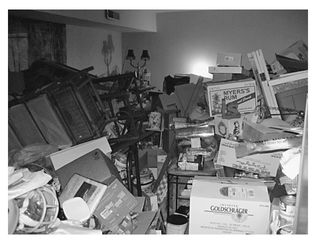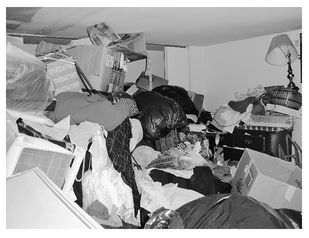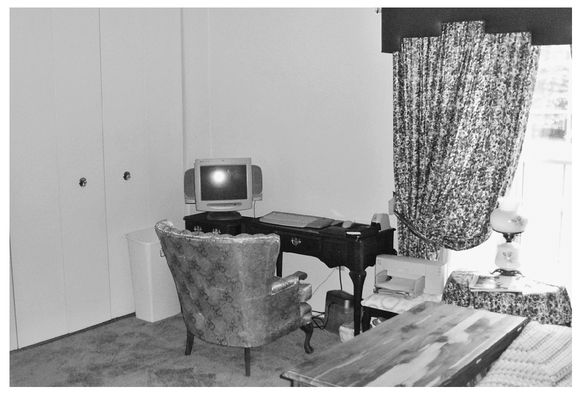The Secret Lives of Hoarders: True Stories of Tackling Extreme Clutter (26 page)
Read The Secret Lives of Hoarders: True Stories of Tackling Extreme Clutter Online
Authors: Matt Paxton,Phaedra Hise
Tags: #General, #United States, #Psychology, #Case Studies, #Psychopathology, #Compulsive Behavior, #Compulsive Hoarding - United States, #Compulsive Hoarding, #Obsessive-Compulsive Disorder

BOOK: The Secret Lives of Hoarders: True Stories of Tackling Extreme Clutter
13.78Mb size Format: txt, pdf, ePub
At the end of Thalia's cleanup things were looking good.

Two years after Thalia's cleanup she'd reverted to her old habitsâand then some. It's our policy not to do a second cleanup except under really exceptional circumstances. We weren't able to help Thalia until she was ready to help herself.
But Thalia was a classic late-stage hoarder and still in denial. She cleaned up in order to keep her house, not because she wanted to give up hoarding. Two years later Thalia called and confessed that her house was full again. But as we talked, it became clear that she was still in denial and only wanted to clean up enough so that her house wouldn't be condemned a second time. I knew that if we came and cleaned, the same cycle would repeat itself, and so I turned her down. I told her that if she gets to the point where she really wants to change, I'll be her biggest supporter.
ROGERWe are all still rooting hard for Roger. During his cleanup, he started out by not trusting the crew at all. He didn't have faith in anyone apart from his sister Kathy. But partway through the job, he opened up and bonded with the group. Once he realized that we weren't going to lie to him or throw away his stuff without his permission, he became much more communicative and friendly. He would talk sports all day long; he had a brilliant mind for details and statistics. The happiest I saw him was when he earned a Clutter Cleaner shirt on day two of his cleanup. This kind of thing, in itself, is a great victory for an advanced hoarder.
As Roger shared stories with us, and his sister did also, we learned that Roger had several serious challenges. He had been abused as a child by someone he trusted outside of the family, and that had scarred him emotionally. His parents had let Roger live with them so that they could, in a way, protect him from his fears and the outside world. When they died, Roger felt almost completely alone. Therapy wasn't an optionânot only was the closest therapist two hours away, but Roger didn't trust anyone enough to even try counseling.
The cleaning led to Roger suffering another big lossâthe sale of the family house. He moved to a smaller house nearby. With so many of his things having been thrown away in the cleanup, he struggled emotionally. His sister Kathy was patient and supportive, and would have done almost anything for him. She helped him land a job, and for a while it looked like Roger was on a good path toward recovery.
The job doing inventory in a warehouse had been located through an organization that trained and found placement for workers with special needs. But Roger had been living alone and on his own terms for so long that he wasn't able to meet some basic societal expectations. He couldn't get to work on time. And when he did show up, he had not bathed, had food stains on his clothes, and crunchy things in his beard. He had trouble staying focused and carrying on simple conversations.
Roger was let go. After that, he went back to hoarding.
Roger's family had done everything right, and Roger worked hard. But without therapy and some connection to the outside world, he couldn't maintain a clutter-free house. Kathy isn't sure that Roger can ever live alone, and he may need home health care support to make sure he eats and bathes.
Roger's family is dedicated to supporting him and making sure he has a place to live, but at this point, Kathy feels like she has tried everything to help him be clean. She is working on accepting and loving Roger for who he is.
Advanced hoarders are all on the same journey that Roger is, moving back and forth along a continuum from clutter to tidy. Their goal may be merely to stay closer to the clean end of the scale, and their loved ones need to be content with that. Luckily, Roger's living conditions are safe, and his family is accepting the reality of his situation.
WENDY AND SAMAfter their cleanup and meetings with social workers and doctors to talk about the prescription pill hoarding, newlywed seniors Wendy and Sam were able to keep their house clean by following some rules and checklists. Sam, who had never been a hoarder, wasn't really contributing to the problem, and he was able to support Wendy, an early-stage hoarder herself, in her efforts to stay clean. Because she wanted this new relationship to work, Wendy had the motivation to stick with it.
Wendy's adult daughter and young granddaughter had been living with them, but after the cleanup Wendy realized that having extra people in the house was a stress button for her. Also, her daughter, having grown up in a hoarder house, had hoarding tendencies herself. She and the granddaughter were working on turning that around by applying the same cleanup rules Wendy and Sam had. But Wendy could see that it was a struggle to have four people in a small house, with at least two of them being recovering hoarders. She asked her daughter to find her own apartment.
Once the house was clean, Wendy and Sam were faced with maintenance issues that Wendy had ignored for years. Also, for the first time ever, they were doing weekly cleaningâdusting, vacuuming, and washing dishes. They decided that the house was just too much work for them to maintain. After Wendy's daughter moved out, Wendy and Sam put the house on the market with the goal of moving to a smaller low-maintenance space.
Throughout the process, Wendy was being honest with herself, and by moving, she imposed space limits on herself. With this, combined with her newly learned cleaning techniques and the support from her children, hers has become a success story.
MICHELLEOnce her house was clean and de-moused, Michelle's two children were returned to her from foster care. Michelle responded well to antianxiety medication. The house stayed clean, so Michelle's social worker considered her a success story. As far as he could see, Michelle had cleaned up, passed inspection, gotten her children back, and was in compliance with her medications. So he closed her case.
A few months after, Michelle decided that she felt so great and things were going so well that she didn't need her medication anymore. Once she quit taking it, she slipped back into anxiety and hoarding, not an unlikely scenario for a Stage 5 hoarder. The house isn't as bad as it was before, but Michelle is definitely on that same path again.
During Michelle's cleaning we had found some drugs in the house, which she said her son had brought in. About a year after the cleanup, I heard from Michelle's case worker that Michelle's son had been convicted on a separate drugrelated charge and was serving time in jail.
Her daughter is still in the house, but she is a teenager and will be moving out soon. After that, unfortunately, there won't be much incentive for Michelle to stay clean. She could easily continue to hoard and fill up the house until neighbors start to complain and city inspectors visit again.
DAISYMiss Daisy had a remarkable recovery for an elderly Stage 5 hoarder. She had several positive factors working for her. One was her terrific support team. Another was the fact that she hadn't been a hoarder all of her life. Daisy didn't start hoarding until after her retirement, so she had experienced what a tidy house felt like, and she understood how to keep it that way. She appreciated order and knew that she had the tools to reach that goal and stay there.
Even though Daisy was in her eighties, she had an alert mind and good health. And her cleaning turned up a string of positives that helped encourage her. First, when her county-provided financial planner learned that Daisy had been a teacher for thirty years, he did a little research and discovered an $85,000 pension that Daisy didn't know she had. Using that, he put together a budget that ensured Daisy would be taken care of for the rest of her life. That was a huge positive that proved to Daisy the benefits of cleaning up and organizing her life.

With Daisy's clutter piled almost to the ceiling, the cleanup crew was afraid of what they might find under it all.

Daisy had a remarkable team of helpers who got her bedroom livable again.
Meanwhile, Daisy's social worker located family members who were living nearby. Daisy had cut off contact with them fifteen years earlier, embarrassed by her hoarding. They thought Daisy had passed away and were thrilled to find her alive and well. Her family welcomed Daisy back into their lives unconditionally, delighted to have their mother, grandmother, and great-grandmother back.
Daisy also had her strong church community. She had volunteered there for years and had endless support and love from the large congregation. That gave her life meaning. Each day when Daisy got up, she had somewhere to go and people who needed her.
With her pension, Daisy could have lived on her own after her house was cleaned. Instead, her family kept asking her to move in with them. She finally decided to sell her house and live with one of her adult grandchildren. She is still there today, in her nineties, volunteering at her church and spending time with her great-grandchildren.
RESOURCES
B
y the planning stage, people usually have hundreds of questions about where to get special tools, or where to donate some items, or simply who to call for more help. As the understanding of hoarding grows, additional resources will become available and added to the resource list on our website at
www.cluttercleaner.com
.
y the planning stage, people usually have hundreds of questions about where to get special tools, or where to donate some items, or simply who to call for more help. As the understanding of hoarding grows, additional resources will become available and added to the resource list on our website at
www.cluttercleaner.com
.
Most of the resources listed here have national coverage, but always look for local solutions as well (key words to search for are included under each topic). Local companies may be able to help find nearby support for other aspects of the project.
ABOUT HOARDINGThe resource section that follows features additional information about the basics of hoarding, including therapists, cleaning companies, and support groups available. To find more information, keywords to search include hoarding, squalor, OCD, saving, collecting, clutter, and organization.
Institute for Challenging Disorganization (ICD):
www.challengingdisorganization.org
www.challengingdisorganization.org
International Obsessive-Compulsive Disorder (OCD) Foundation:
www.ocfoundation.org
www.ocfoundation.org
National Association of Professional Organizers (NAPO):
www.napo.net
www.napo.net
Hoarding can have multiple triggers and accompanying mental healthârelated issues. Following are some of the top treatment centers in the country for hoarding, anxiety, OCD, and related disorders. Most cities and many universities also have local specialists. To find more information, keywords include OCD, obsessive-compulsive disorder, hoarding, phobia, anxiety, depression, stress, body dysmorphic disorder, trichotillomania, panic, agoraphobia, social anxiety, and PTSD.
Lakeside Center for Behavioral Change (Dr. Renae Reinardy):
www.lakesidecenter.org
www.lakesidecenter.org
Kansas City Center for Anxiety Treatment (Dr. Lisa Hale):
www.kcanxiety.com
www.kcanxiety.com
The Institute of Living (Dr. David Tolin):
www.compulsivehoarding.org
www.compulsivehoarding.org
Panic/Anxiety/Recovery Center (PARC):
www.beyondanxiety.com
www.beyondanxiety.com
Compulsive Hoarding Center (Dr. Robin Zasio):
www.compulsivehoardingcenter.com
www.compulsivehoardingcenter.com
Obsessive-Compulsive Disorder Institute of Greater New Orleans (Dr. Suzanne Chabaud):
www.ocdigno.com
www.ocdigno.com
Other books
No-One Ever Has Sex On A Tuesday: A Very Funny Romantic Novel by Bloom, Tracy
Widowmaker Jones by Brett Cogburn
Nocturnal Obsession by Lolita Lopez
#1 Blazing Courage by Kelly Milner Halls
So Gone by Luckett, Jennifer
Queen's Own Fool by Jane Yolen
Needing Harte (1-800-DOM-Help) by Marilu Mann
On the Mountain by Peggy Ann Craig
Blind Justice by James Scott Bell